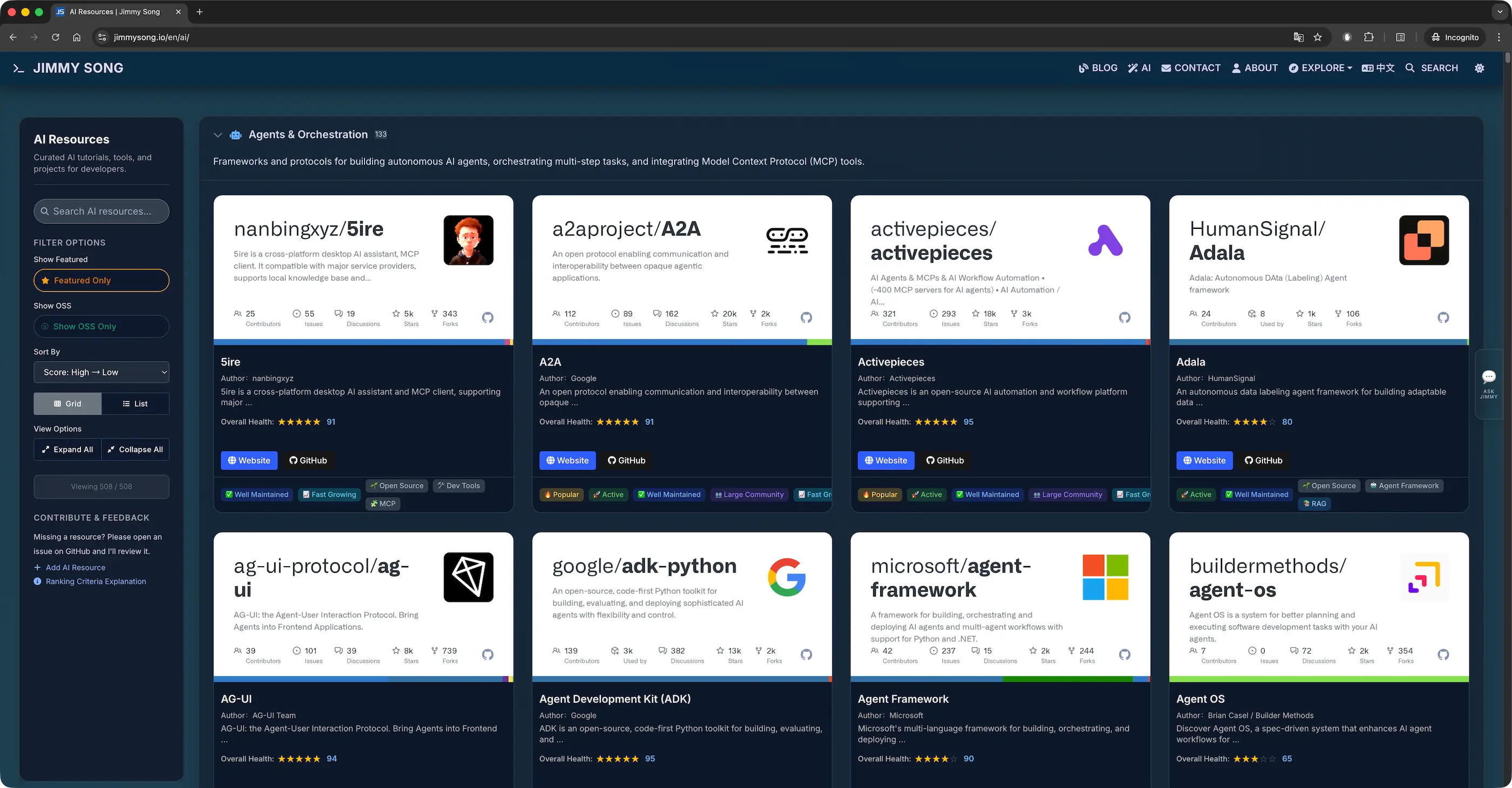During the National Day holiday, I made several major optimizations to the AI Resources page . These updates include a significant expansion in the number of resources, enhanced filtering and display features, and the introduction of a new project health scoring system. My goal is to help readers efficiently discover, screen, and evaluate high-quality AI projects.

AI Library Hub: https://jimmysong.io/ai/
Overview & Resource Distribution
After several rounds of curation, the AI Resources page now features over 500 entries, including more than 400 open-source projects (with GitHub repositories). Resource types cover tutorials, tools, paper implementations, model repositories, and more, with bilingual indexing support (/zh/ and /en/) for users in different languages.
As the number of resources grows, the directory becomes more comprehensive, but also brings new challenges of “information overload” and decision fatigue. Therefore, recent optimizations have focused on improving filtering efficiency and information readability.
Interaction & Display Experience Optimization
To address the issue of “too many resources, hard to choose,” this update focuses on optimizing frontend interaction and display:
- Category Optimization: The resource categorization now aligns with mainstream AI industry taxonomy, covering 10+ dimensions such as “Agents & Orchestration,” “Models & Foundations,” “Training & Fine-tuning,” “Inference & Serving,” “Data & Retrieval,” “Dev Tools & SDKs,” “Evaluation & Monitoring,” “Applications & Products,” “UI & Integration,” and “Learning Resources.”
- Enhanced Filters: The list page filter logic has been improved, supporting multi-dimensional filtering by category, tag, open-source status (GitHub), language, etc., effectively reducing irrelevant results.
- Card & Style Adjustments: Project card layouts have been optimized to highlight titles, brief descriptions, and key tags. Status badges and score placeholders have been added to the card footer.
These optimizations help users quickly locate projects of interest and instantly understand their basic status.
Introducing a Scoring System: Comprehensive Project Health Assessment
With the surge in resource numbers, tags alone are no longer sufficient for intuitive project evaluation. The resource list page now features an “Overall Score” field to help readers quickly assess project activity and health.
The core idea: high Star counts do not necessarily mean high activity—what truly matters is ongoing maintenance and strong community engagement. The overall score combines “Popularity / Activity / Community” into a 0-100 value for easy comparison.
Scoring System Design & Implementation
To ensure the scoring system is scientific and extensible, the design and implementation details are documented in depth. Below is a summary; see the references at the end for more details.
- Data Sources: Mainly collects GitHub repository data, including Stars, Forks, open issues, last commit time (
pushed_at), contributor count, release times, etc. - Metric Breakdown & Weights: Health is divided into “Popularity,” “Activity,” and “Community,” with sample weights of 0.4×Popularity + 0.4×Activity + 0.2×Community.
- Calculation Strategy: Star count uses logarithmic/segmented mapping to balance outliers; activity is based on recent commit time and frequency; community is measured by contributor count and issue activity.
- Backend Implementation: Uses Cloudflare Workers (or Pages Functions) to periodically fetch GitHub metrics and write to Cloudflare D1. The frontend injects scores and badges into static pages via HTMLRewriter at render time, requiring no extra client requests and ensuring fast load times.
UI Changes & Display Examples
This update brings the following UI changes:
- List Page: Each project card now displays a score badge (e.g., 86 / 100) at the top right or bottom, and status badges such as “New / Hot / Inactive / Archived” in the tag area. Thumbnails for inactive or archived projects are automatically grayscaled for easy identification.
- Detail Page: The sidebar now features a “Project Health Score” section, showing sub-scores for popularity, activity, and community, as well as the overall score, with progress bars for visual clarity.
These changes help users make faster decisions while browsing and filtering, improving the overall experience.
Feedback & Contribution
To continuously improve the resource library, your feedback and contributions are welcome:
- If you find incorrect GitHub links, abnormal Star/status displays, or want to recommend new projects, please submit an Issue.
- Suggestions on scoring weights or thresholds are also welcome in Issues. Common suggestions may become configurable and documented.
Submit here: AI Resource Feedback & Recommendation
Future Plans & Outlook
Ongoing optimizations for the resource page will focus on:
- Adding historical snapshots and trend charts (weekly/monthly) to help readers track project popularity over time.
- Introducing more external metrics (e.g., OpenSSF Scorecard, dependency status) to enrich scoring dimensions.
- Further filter improvements, such as “show only high-score projects” for quick screening.
These plans will further enhance the professionalism and utility of the resource library. Stay tuned and feel free to share your suggestions.
Summary
This National Day update focuses on improving the efficiency of browsing, filtering, and evaluating high-quality projects. The scoring system is not an authoritative ranking, but a decision-making reference for readers. Thank you for your continued support—please use GitHub to report issues or recommend new projects and help the AI resource library keep growing.